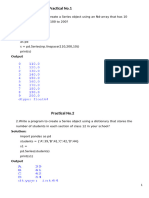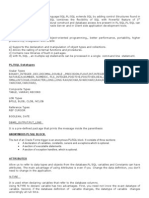TCL Commands in SQL o in SQL
Uploaded by
ashishraikwar2933TCL Commands in SQL o in SQL
Uploaded by
ashishraikwar2933* TCL Commands in SQL o In SQL, TCL stands for Transaction control language.
o A single unit of work in
a database is formed after the consecutive execution of commands is known as a transaction. o There
are certain commands present in SQL known as TCL commands that help the user manage the
transactions that take place in a database. o COMMIT. ROLLBACK and SAVEPOINT are the most
commonly used TCL commands in SQL.
1. COMMIT
COMMIT command in SQL is used to save all the transaction-related changes permanently to
the disk. Whenever DDL commands such as INSERT, UPDATE and DELETE are used, the changes
made by these commands are permanent only after closing the current session. So before
closing the session, one can easily roll back the changes made by the DDL commands. Hence, if
we want the changes to be saved permanently to the disk without closing the session, we will
use the commit command.
Syntax: 1. COMMIT;
2. SAVEPOINT
We can divide the database operations into parts. For example, we can consider all the insert
related queries that we will execute consecutively as one part of the transaction and the delete
command as the other part of the transaction. Using the SAVEPOINT command in SQL, we can
save these different parts of the same transaction using different names. For example, we can
save all the insert related queries with the savepoint named INS. To save all the insert related
queries in one savepoint, we have to execute the SAVEPOINT query followed by the savepoint
name after finishing the insert command execution.
Syntax: 1. SAVEPOINT savepoint_name;
3. ROLLBACK
While carrying a transaction, we must create savepoints to save different parts of the
transaction. According to the user's changing requirements, he/she can roll back the transaction
to different savepoints. Consider a scenario: We have initiated a transaction followed by the
table creation and record insertion into the table. After inserting records, we have created a
savepoint INS. Then we executed a delete query, but later we thought that mistakenly we had
removed the useful record. Therefore in such situations, we have an option of rolling back our
transaction. In this case, we have to roll back our transaction using the ROLLBACK command to
the savepoint INS, which we have created before executing the DELETE query
. Syntax: 1. ROLLBACK TO savepoint_name;
You might also like
- Advanced SQL Interview Questions and AnswersNo ratings yetAdvanced SQL Interview Questions and Answers5 pages
- Introduction To Transaction Control LanguageNo ratings yetIntroduction To Transaction Control Language10 pages
- C3-WK02-DY02-PracticeExercise - SolutionsNo ratings yetC3-WK02-DY02-PracticeExercise - Solutions1 page
- Commit, Rollback and Savepoint SQL Commands: CommandNo ratings yetCommit, Rollback and Savepoint SQL Commands: Command6 pages
- SQL Tutorial - Commit: Insert Into ValuesNo ratings yetSQL Tutorial - Commit: Insert Into Values4 pages
- 2 - Content - DRL, DCL, TCL, Joins and SubqueriesNo ratings yet2 - Content - DRL, DCL, TCL, Joins and Subqueries36 pages
- 2 Algorithms For Query Processing OptimizationNo ratings yet2 Algorithms For Query Processing Optimization46 pages
- Creating Custom Error Messages in SQL Server and Using With VFP - 02nov2006No ratings yetCreating Custom Error Messages in SQL Server and Using With VFP - 02nov20065 pages
- How Sqoop Works?: Sqoop "SQL To Hadoop and Hadoop To SQL"No ratings yetHow Sqoop Works?: Sqoop "SQL To Hadoop and Hadoop To SQL"27 pages
- DBMS Interview Questions-Interview Questions and Answers-23340No ratings yetDBMS Interview Questions-Interview Questions and Answers-233407 pages
- 70 461 Exam Guide Querying Microsoft SQL Server 2012 PDFNo ratings yet70 461 Exam Guide Querying Microsoft SQL Server 2012 PDF10 pages

























































































